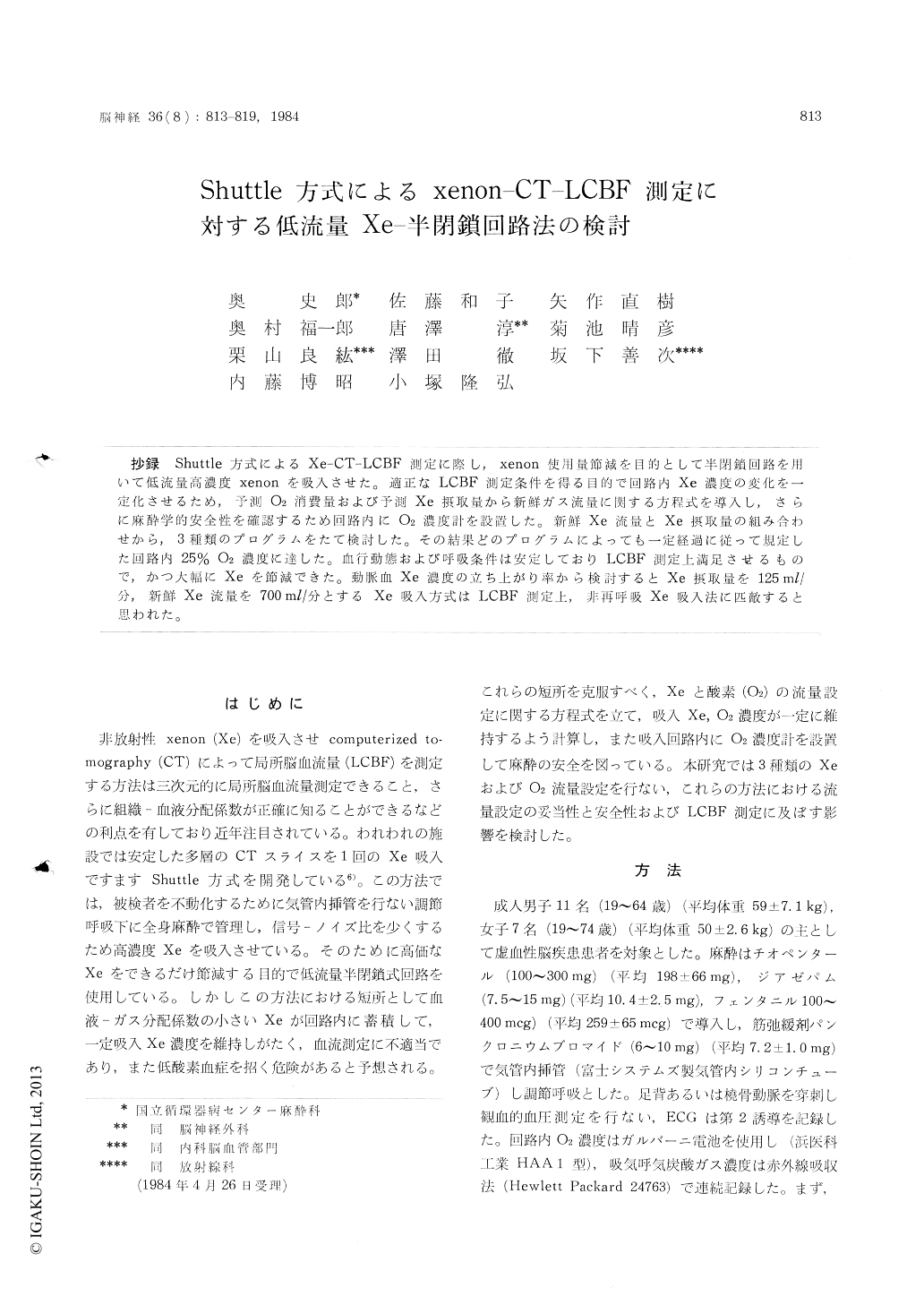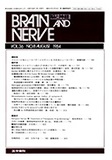Japanese
English
- 有料閲覧
- Abstract 文献概要
- 1ページ目 Look Inside
抄録 Shuttle方式によるXe-CT-LCBF測定に際し,xenon使要量節減を目的として半閉鎖回路を用いて低流量高濃度xenonを吸入させた。適正なLCBF測定条件を得る目的で回路内Xe濃度の変化を一定化させるため,予測O2消費量および予測Xe摂取量から新鮮ガス流量に関する方程式を導入し,さらに麻酔学的安全性を確認するため回路内にO2濃度計を設置した。新鮮Xe流量とXe摂取量の組み合わせから,3種類のプログラムをたて検話した。その結果どのプログラムによっても一定経過に従って規定した回路内25%O2濃度に達した。血行動態および呼吸条件は安定しておりLCBF測定上満足させるもので,かつ大幅にXeを節減できた。動脈血Xe濃度の立ち上がり率から検討するとXe摂取量を125ml/分,新鮮Xe流量を700ml/分とするXe吸入方式はLCBF測定上,非再呼吸Xe吸入法に匹敵すると思われた。
For the purpose of decreasing the volume of expensive xenon, anesthesia with minimal-flow xenon and semiclosed circuit were induced for computed tomographic LCBF measurement. Eighteen patients with ischemic cerebral disease were studied. Anesthesia was induced with minimum dose of thiopental, diazepam and fentanyl. Muscle relaxation was obtained by means of pancuronium bromide. Patients were intubated and ventilated mechanically with flows of 6l/min. 02 for 20 to 30 minutes to eliminate nitrogen from the system. 02 concentrations in semiclosed circuit were monitored throughout the procedures using galvanic battery. Endtidal CO2 tension was also measured for maintaining normocarbia. Blood gas analyses were carried out before xenon inhalation, during xenon inhalation and immediately before stopping inhalation of xenon-oxygen mixture. Xenon inhalation programs were subdivided into three groups, each of them consisted of 6 patients. The formula for calculating fresh gas flow for low flow semiclosed circuit was introduced according to Shimoji's which was based on the original formula of Foldes. O2 concentration in circuit was predicted to be 25%. Mean xenon uptake for initial 20 minutes was predicted to be 125ml/min. or 360ml/min.
CRO2=((FO2-VO2)/(FO2+FXe-VO2-VXe))
(CR02 : 02% in semiclosed circuit. F02 : fresh 02 flow ml/min. FXe : fresh xenon flow ml/min. VO2 : oxygen consumption ml/min. VXe : mean xenon uptake ml/min.)
The first group started xenon inhalation during pure xenon inflow into semiclosed circuit for two minutes and followed by about 68% xenon in 02 inhalation for 23 munites. FXe and VXe were fixed at 700ml/min and 360ml/min respectively. The second group was set at the same conditions as the first group except FXe and VXe as shown in Fig. 2. The third group inhaled about 63% xenonoxygen mixture affer four minutes pure xenon inflow. Xenon concentrations in trachea, carotid artery and jugular vein were estimated from the conversion into equivalent enhancement in CT units for every four minutes on line. Fig. 3 shows the 02 concentration change in semiclosed circuit, endtidal CO2 tension and percent change of mean arterial pressure. After 20 minutes xenon inhalation 02 concentration in each group closed to 25% which was predicted 02 concentration of the third group closed more rapidly to 25% than other groups. Normocarbia and stable hemodynamics could be confirmed throughout the procedures in each group. Fig. 5 shows xenon washin curves in trachea and xenon concentration change in carotid artery and jugular vein during xenon inhalation. The washin curves in trachea are quite different in each group. However, xenon concentration change in artery and vein differ slightly each other. It was concluded that the xenon inhalationmethod of third group using semicloesd circuit might be fairly similar to the nonrebreathing xenon inhalation in terms of xenon washin curve in lung and xenon concetration of artery. The economical standpoint of saving for expensive xenon LCBF meusurment was also satisfied.

Copyright © 1984, Igaku-Shoin Ltd. All rights reserved.


